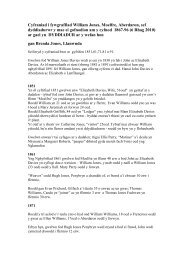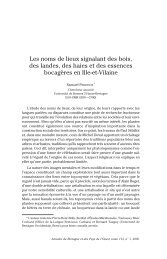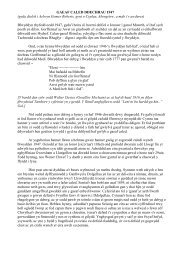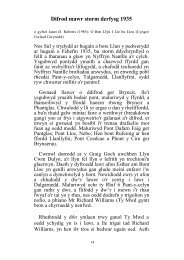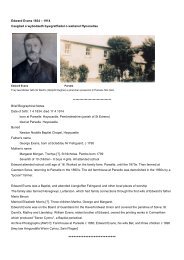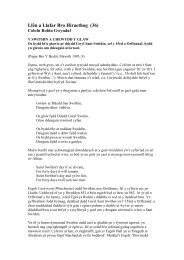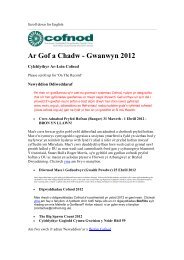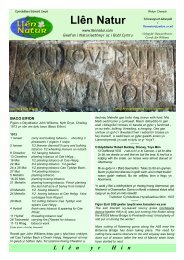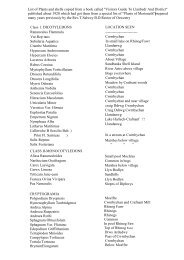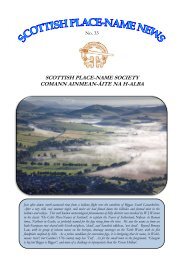Loughor. — A corruption <strong>of</strong> Llychwr, which forms a part <strong>of</strong> <strong>the</strong> Welsh name Castell Llychwr. The castle wasbuilt on an em<strong>in</strong>ence above <strong>the</strong> estuary <strong>of</strong> <strong>the</strong> river Llychwr. The name is a compound <strong>of</strong> llwch, an <strong>in</strong>let <strong>of</strong>water, a lake, a lough; <strong>and</strong> dwr, water. The ancient name was Treafanc, from <strong>the</strong> great number <strong>of</strong> beaversabound<strong>in</strong>g <strong>in</strong> <strong>the</strong> contiguous waters, afanc be<strong>in</strong>g <strong>the</strong> old Welsh name <strong>of</strong> <strong>the</strong> beaver. Some suppose <strong>the</strong> <strong>place</strong>to have been <strong>the</strong> Leucamm <strong>of</strong> Antonius. English name — Castlelock.Laleston. — A translation <strong>of</strong> <strong>the</strong> Welsh Trelalys, <strong>the</strong> town <strong>of</strong> Lales. The parish <strong>and</strong> village were so called <strong>in</strong>honour <strong>of</strong> Lales, who built <strong>the</strong> Neath <strong>and</strong> Margam Abbeys. Hav<strong>in</strong>g received a portion <strong>of</strong> l<strong>and</strong>, lie built amansion here, demolished <strong>the</strong> old church, <strong>and</strong>, <strong>in</strong> 1115, built a new one near his mansion.Leckwith. — This name is one <strong>of</strong> <strong>the</strong> many <strong>in</strong>stances <strong>of</strong> <strong>the</strong> sad havoc <strong>the</strong> Normans played with Welsh<strong>names</strong> when <strong>the</strong>y settled <strong>in</strong> Glamorgan <strong>in</strong> <strong>the</strong> eleventh century. It is a corruption <strong>of</strong> llechwedd, <strong>the</strong> steep <strong>of</strong> ahill, hill-side. English name — Slopeton.Lavernock. — Ano<strong>the</strong>r Norman corruption <strong>of</strong> Llanwernog, which means a church on a meadow. Englishname — Meadow Church.Lisfane. — An Anglicized form <strong>of</strong> <strong>the</strong> Welsh Llys-faen. Llys, court; nfaen, stone. It appears that <strong>the</strong>re was alarge stone <strong>in</strong> <strong>the</strong> vic<strong>in</strong>ity, upon which <strong>the</strong> law court was held <strong>in</strong> ancient times; hence <strong>the</strong> name. Englishname— Stonecourt.Llancarvan. — "Bonedd y Sa<strong>in</strong>t" tells us <strong>the</strong> church was dedicated to Carvan. Iolo MSS. <strong>in</strong>form us that here<strong>the</strong> first monastery was built <strong>in</strong> Brita<strong>in</strong> by Germanus, from which circumstance <strong>the</strong> learned editor th<strong>in</strong>ks thatLlancarvan signifies <strong>the</strong> church <strong>of</strong> Germanus, Carfan be<strong>in</strong>g a corruption <strong>of</strong> <strong>the</strong> sa<strong>in</strong>t's name. English name —Carvanton.Llanharan. — In some ancient MSS. it is written Llanaron from <strong>the</strong> church be<strong>in</strong>g dedicated to Julius <strong>and</strong>Aaron. English name — Aaronton.Llanharry. — It appears that Llanarai was <strong>the</strong> ancient name, <strong>and</strong> that Garai was <strong>the</strong> founder <strong>of</strong> <strong>the</strong> church.English name— Garton.Llanilid. — The church was dedicated to Ilid f who, accord<strong>in</strong>g to some, was <strong>the</strong> first to <strong>in</strong>troduce Christianityto <strong>the</strong> Celts <strong>in</strong> <strong>the</strong> first century. English name— Ilidton.Llanwonno. — The church was dedicated to Gwynoy Gwyno hav<strong>in</strong>g been changed to Wonos. English name— Whitby.Llanfaes. — It was anciently called Llan Ffagan Fach, <strong>in</strong> honour <strong>of</strong> Ffagan, <strong>the</strong> founder <strong>of</strong> <strong>the</strong> church. Thepresent name implies that Ffagan's Church was demolished, <strong>and</strong> <strong>the</strong> present one was built on a spot wherea memorable battle was fought. Maes, a high field, is to be understood here <strong>in</strong> a martial sense. English name— Churchfield.Llanedeyrn. — The church was dedicated to Edeyrn, <strong>the</strong> son <strong>of</strong> Gwr<strong>the</strong>yrn, who flourished <strong>in</strong> <strong>the</strong> fifteenthcentury. He established a religious community <strong>of</strong> 300 members <strong>in</strong> this <strong>place</strong>. English name — Rexton.Ll<strong>and</strong>aff. — The name signifies a church on <strong>the</strong> Taff. It was built, accord<strong>in</strong>g to <strong>the</strong> " Welsh Chronicles," <strong>in</strong> <strong>the</strong>year 171 by Lleurwg (Lucius), <strong>and</strong> <strong>the</strong> see is reckoned to be <strong>the</strong> most ancient <strong>in</strong> Brita<strong>in</strong>. English name —Taffchurch.Ll<strong>and</strong>dewi. — The church was dedicated to Dewi, <strong>the</strong> patron sa<strong>in</strong>t <strong>of</strong> Wales. English name — Davidston.Ll<strong>and</strong>eilo-Talybont. — The church was founded by Teilo, bishop <strong>of</strong> Ll<strong>and</strong>aff, <strong>in</strong> <strong>the</strong> sixth century. Talybonthas been already expla<strong>in</strong>ed. English name — Bridgechurch.Llanrhidian. — From Rhidian, a student <strong>in</strong> Cenydd's sem<strong>in</strong>ary at Gower, <strong>and</strong> <strong>the</strong> founder <strong>of</strong> <strong>the</strong> church.English name — Rhidianton.Llanmadog. — The church was dedicated to Madoc, <strong>the</strong> son <strong>of</strong> Gildas. English name — Madocton.Llysworney. — A mutilation <strong>of</strong> <strong>the</strong> Welsh Llysy-fronydd, which, also, is a corruption <strong>of</strong> Llys Bro Nudd. BroOrig<strong>in</strong> <strong>of</strong> Place-<strong>names</strong> <strong>in</strong> Wales & Monmouthshire Page 63
means a cultivated region, a vale, <strong>and</strong> Nudd is supposed to have held a court (llys) here; hence <strong>the</strong> name.English name — Court Vale.Llwydcoed. — Llwyd, grey; coed y wood. In <strong>the</strong> sixteenth century <strong>the</strong> forest <strong>of</strong> Llwydcoed was reckoned tobe one <strong>of</strong> <strong>the</strong> f<strong>in</strong>est <strong>in</strong> <strong>the</strong> Pr<strong>in</strong>cipality. English name — Greywood.Llwynpia. — From a farmhouse so named. Llwyn, bush, grove; pia, a pie. English name — Pieton.Llanishen. — The church was dedicated to Isan, a disciple <strong>of</strong> Illtyd. Isan has been corrupted to Ishen.English name — Isanton.Llansamlet. — " Bonedd y Sa<strong>in</strong>t " tells us that <strong>the</strong> church was founded by Samled, who flourished <strong>in</strong> <strong>the</strong>seventh century. The <strong>place</strong> is sometimes called Llwynbrwydrau, grove <strong>of</strong> battles, which probably refers tosome battles that were fought here. English name — Samled.Llantrisant.- -Its ancient name was Llangawrdaf, so called <strong>in</strong> honour <strong>of</strong> Cawrdaf, who founded a sem<strong>in</strong>aryhere. Llantrisant implies that <strong>the</strong> church was dedicated to three sa<strong>in</strong>ts, namely, Illtyd, Tyfodwg, <strong>and</strong> Gwyno;hence <strong>the</strong> peculiar name. English name — Sa<strong>in</strong>tham.Llanillteyrn. — Illtern is a corruption <strong>of</strong> Elldeyrn f <strong>the</strong> name <strong>of</strong> <strong>the</strong> sa<strong>in</strong>t who founded <strong>the</strong> church <strong>in</strong> <strong>the</strong> fifthcentury. Elldeyrn signifies a strange or foreign k<strong>in</strong>g. English name — K<strong>in</strong>gschurch.Mel<strong>in</strong> Griffith. — This <strong>place</strong> derives its name from a Mr. Griffith, who kept a mill (mel<strong>in</strong>) here to gr<strong>in</strong>d corn for<strong>the</strong> farmers <strong>of</strong> <strong>the</strong> district. English name —Griffith's Mill.Mel<strong>in</strong> Crythan. — So called from a mill situated on <strong>the</strong> brook Crythan. Crythan means a little crooth, or itmay come from <strong>the</strong> verb cryddu, to stretch, or extend round. English name — Croothmill.Michaelstone-super-Ely. — A translation <strong>of</strong> <strong>the</strong> Welsh Llanfihangel-ar-Elai, from <strong>the</strong> dedication <strong>of</strong> <strong>the</strong>church to St. Michael, <strong>and</strong> its situation on <strong>the</strong> river Ely.Mumbles. — This <strong>place</strong> was anciently known by <strong>the</strong> name Oystermouth, so called, it is said, from itsabundance <strong>of</strong> oysters, <strong>of</strong> which even now considerable quantities are yearly sent to London <strong>and</strong> o<strong>the</strong>r<strong>place</strong>s. In "Y Cymrodor," vol. vi., part II., page 149, one writer says that " whe<strong>the</strong>r <strong>of</strong> Sc<strong>and</strong><strong>in</strong>avian <strong>orig<strong>in</strong></strong>, asa local antiquary <strong>of</strong> repute would have it, or Celtic as is sometimes contended, it is certa<strong>in</strong> <strong>the</strong> village owesnoth<strong>in</strong>g to <strong>the</strong> oysters <strong>of</strong> <strong>the</strong> neighbour<strong>in</strong>g sea for its name, <strong>the</strong> early form <strong>of</strong> writ<strong>in</strong>g which was *Ostremuere.' " The present name was probably derived from <strong>the</strong> perpetual mumbl<strong>in</strong>g <strong>of</strong> <strong>the</strong> sea.Manselfield. — So called <strong>in</strong> honour <strong>of</strong> <strong>the</strong> Mansel family. William Mansel, Esq., Penrice Castle, was <strong>the</strong>owner <strong>of</strong> <strong>the</strong> estate <strong>in</strong> <strong>the</strong> reign <strong>of</strong> Henry VI.Maesteg. — The popular Welsh name was Llwyni, bushes, from a farmstead <strong>of</strong> <strong>the</strong> name, but was changedto Llyfnwy by Nathan Dyfed at an eisteddfod held here <strong>in</strong> 1839. The present name is a compound <strong>of</strong> mats, afield, which probably comes from <strong>the</strong> Sanskrit matrix terra; <strong>and</strong> teg, fair; so called from ano<strong>the</strong>r farmsteadbear<strong>in</strong>g <strong>the</strong> name. English name — Fairfield.Merthyr Tydfil. — The town takes its name from <strong>the</strong> martyr Tydfil, daughter <strong>of</strong> Brychan Bryche<strong>in</strong>iog, whowas brutally murdered here by <strong>the</strong> hea<strong>the</strong>n Picts, August 23rd, 420. Some are <strong>of</strong> op<strong>in</strong>ion that <strong>the</strong> ParishChurch is built on <strong>the</strong> scene <strong>of</strong> murder, <strong>and</strong> hence dedicated to Tydfil. English name — Tydfilton.Mawdlam. — A corruption <strong>of</strong> Magdalen. An old church <strong>in</strong> <strong>the</strong> parish was dedicated to St. Mary Magdalen.English name — Magdalen.Morriston. — So called <strong>in</strong> honour <strong>of</strong> Sir John Morris, Clasmont, who built a large copper works here <strong>in</strong> 1768,<strong>and</strong> <strong>the</strong>reby rendered <strong>the</strong> largest quota to <strong>the</strong> growth <strong>of</strong> this populous <strong>place</strong>.Margam. — Morgan Mwynfawr, <strong>the</strong> Courteous, founded Margam Abbey, which was known for somecenturies by <strong>the</strong> name <strong>of</strong> Morgan, <strong>and</strong> ultimately it was changed <strong>in</strong>to Margam. Rees Meyric believed that "Robert (Consul) founded Morgan (Margam) 1146, <strong>and</strong> was benefactor to <strong>the</strong> Abbey <strong>of</strong> Neath seventeenyears before Morgan was founded." — " Morganie Archaiographioe," page 29. English name — Morganton.Orig<strong>in</strong> <strong>of</strong> Place-<strong>names</strong> <strong>in</strong> Wales & Monmouthshire Page 64
- Page 1 and 2:
HANDBOOK OF THE ORIGIN OF PLACE-NAM
- Page 3 and 4:
§ § § § §The Author begs to st
- Page 5 and 6:
pitiful cries of the railway offici
- Page 7 and 8:
Bishop Percy says that "in England,
- Page 9 and 10:
The city of Chester is still popula
- Page 11 and 12:
There's Cumwhitton, Cumwhinton, Cum
- Page 13 and 14:
Llwyn in its primary' sense means a
- Page 15 and 16: PLACE-NAMES IN WALES.Wales. — The
- Page 17 and 18: Church are generally dedicated to e
- Page 19 and 20: think he was a contemporary of St.
- Page 21 and 22: Rhosbeirio. — Rhos, a moor, a dry
- Page 23 and 24: of Brecknock," states that this vic
- Page 25 and 26: Cam cnwir ef Cwmdu,Cwm gwyn yw & n
- Page 27 and 28: Penderyn. — A corruption probably
- Page 29 and 30: Ardudwy. — Ar, upon or above; tud
- Page 31 and 32: to mark its pre-eminence over the o
- Page 33 and 34: Some think that eirw is a corruptio
- Page 35 and 36: present form — Caerfyrddin.Abergw
- Page 37 and 38: place of refuge; hence the name. En
- Page 39 and 40: Llansawyl. — The church was dedic
- Page 41 and 42: eject. The village took its name fr
- Page 43 and 44: house, and attempted to kill an inf
- Page 45 and 46: Gwydir. — Prima facie one may tak
- Page 47 and 48: Nefyn. — The church was probably
- Page 49 and 50: DENBIGHSHIRE.Anglicized form of Din
- Page 51 and 52: Llangollen. — From Collen, a sain
- Page 53 and 54: hands into their pockets to pay a c
- Page 55 and 56: Cefn. — The name signifies a ridg
- Page 57 and 58: Maesgarmon. — Named in honour of
- Page 59 and 60: Abertridwr. — Tridwr, three water
- Page 61 and 62: it is said, was originally built by
- Page 63 and 64: Cwmllynfell. — Cwm, a narrow vale
- Page 65: Gwarycaeau. — Gwdr, the nape of t
- Page 69 and 70: Penrhiwfer.- Pen, head, top; rhiw,
- Page 71 and 72: Port Talbot. — So called in 1835
- Page 73 and 74: Trealaw. — This appellation was g
- Page 75 and 76: Aberdyfi. — So called from its si
- Page 77 and 78: Llanddwywe. — From Dwywau, a desc
- Page 79 and 80: Crickhowell and some in the directi
- Page 81 and 82: Griffithstown. — This village was
- Page 83 and 84: and gwy, water. Treiddiod troth tna
- Page 85 and 86: derive Tintern from din, fortified
- Page 87 and 88: Caersws. — It appears that the Ro
- Page 89 and 90: English name — Ervylton.Llanymech
- Page 91 and 92: Angle. — Probably from the angle-
- Page 93 and 94: Gellyswick. — Another hybrid. Gel
- Page 95 and 96: that the two rivers in their flowin
- Page 97 and 98: ecame the bishop of the see, and wa
- Page 99 and 100: earth formerly stood on a summit on
- Page 101 and 102: Pilleth. — A corruption of pwll,
- Page 103 and 104: Howells, Rev. J., Mountain AshHowel
- Page 105 and 106: Williams, D., PenywernWilliams, Rev



